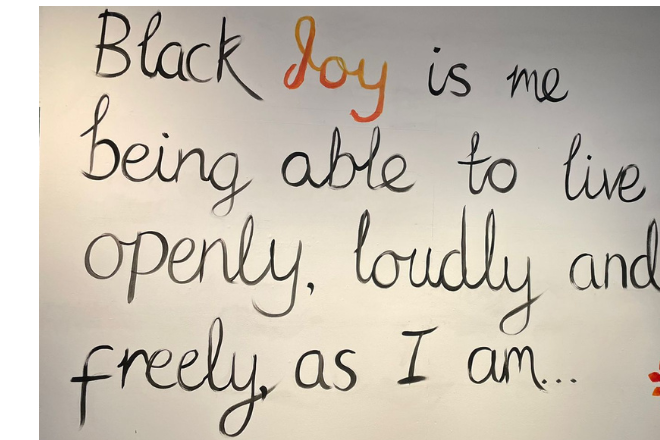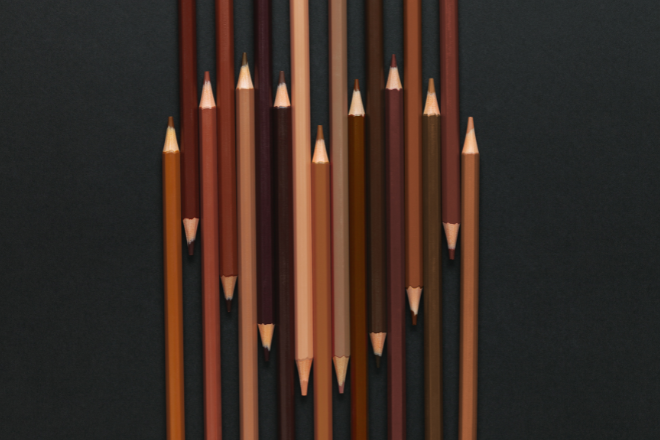This blog was written by David Tovey (pictured above next to Amanda's self portrait) and Amanda Sinclair from Arts & Homelessness International, the global network of arts and homelessness.
David
If someone had told me that I would be leading an international charity 10 years ago I would have told them where to go! At that time, I was going through one of the toughest periods of my life, I had severe health problems which had caused me to become street homeless. You couldn’t get much lower in life. Through the help of art and many friends, I rebuilt my life and now lead Arts & Homelessness International, alongside Matt Peacock.
If this can happen for me it can happen for others, something we believe strongly in at Arts & Homelessness International. Our vision is a world in which creativity is an integral part of homelessness and people who are or have been homeless are an intrinsic part of the arts. We focus on connecting and strengthening projects and advocating for arts to be part of homelessness support and policy. We do this through international exchanges, events, research and training. Co-production is at the heart of everything we do, with 50% of our staff and board made up of people who are or have been homeless. Having lived experience embedded in our charity helps us create our specialised training and pioneering leadership programmes. Without lived experience, we wouldn’t be able to do what we do. Our Co-Production and Cultural Spaces Responses to Homelessness training has been fully co-produced and is updated annually with the help of our co-creators. Our next, yearlong, Associate's Leadership Programme is being designed by the first cohort of amazing artists with lived experience.
Cultural spaces – libraries, galleries, museums, arts centres – for generations have been a safe space and a lifeline for many homeless people. Places of refuge, sanctuary, warmth, intellectual nourishment and engagement with culture. There are many thousands of cultural spaces around the world, from Dallas City Library to Tate Modern, where homeless people feel welcome on a daily basis. We have been working with cultural spaces around the globe to help deepen access and involvement for our community, increasing opportunities to engage with culture. The National Justice Museum in Nottingham is an example of this work.
One of our associate artists Amanda partnered up with them and shares her incredible journey below.
Amanda

During my 50 days of paid work experience at The National Justice Museum (NJM), I undertook the task of making a visual diary with detailed written coverage. I hope that my record of the last six months may provide valuable insight for the museum, particularly when exploring future opportunities for people who may lack the qualifications to work within established organisations, such as museums.
From the day I was interviewed, the museum’s creative producer and curator, Andrea Hadley-Johnson, treated me not only as an equal but as a valued member of the creative team. This inclusion and warmth were also shown within the creative team and museum employees.
It was extremely useful on my first day to be given a tour of the museum; I was equally enthralled and devastated by the range of historical content. The contents of the collection immediately provided an insight into the consequence of injustice and human suffering. To witness such a vast and intact piece of history made a huge impact in furthering my understanding that establishments such as The National Justice Museum can and are changing public perception with honest dialogue and creating a culture of inclusion.
Within my first month in the placement, I was able to witness first-hand the important work taking place. The creative narrative flowing through the exhibitions and workshops undoubtedly provides a platform for change and, more importantly, engagement with people and communities disconnected from establishments due to systemic prejudice and bigotry.
Having spent many years outside of the traditional framework of employment, I was taken aback at the kindness, help and guidance I received. I was included in every decision-making process, which not only encompassed my overall work plan but also included being asked how my payments were to be made in benefit to myself. This provided me with a new progressive insight into the changes within teamwork and co-creation. Ideation meetings were the first time I had witnessed a collection of staff members working together in harmony. There was no boss, no egos from senior workers and a collective, productive response from all who attended. I was included in all these meetings, and my thoughts and feedback were always valued.
‘Make It Yours’ Workshops
My involvement in the museum’s workshops was thoroughly enjoyable, speaking as both an observer and a participant. I witnessed skilled artists leading and teaching groups of various ages, abilities and backgrounds in a safe and friendly environment. Engaging as a participant gave me valuable insight into the workshops and will assist my understanding of people’s needs when leading independent classes in the future. During these workshops, I witnessed compassion, learning and friendship within the positive connections provided by the form of art. Assistance from members of the creative team supported the artists and provided a source of comfort and companionship to this small community of people.
Documentation of Exhibition Artefacts
My work experience included the installation of The Protest Exhibition. This was invaluable insight into the mammoth task of creating an exhibition space, watching deadlines being met, and seeing a variety of artists and craftspeople involved in installing their pieces. The problems they encountered were met with humour and grace and I could see that the result, which appeared effortless, was only made possible because of the co-production.
Curation-Cataloguing, Labelling, Marking
I was given the opportunity to help record artefacts for the collection. These tasks are often laborious and time-consuming but gave me a deeper understanding into a very different process. The recording of historical artefacts holds the same value as exhibition items and are cherished with the same respect, which shows consideration and worth to each person who left an account or responded to each exhibition.
Museum on the Road
Taking the museum bike into local communities was always a joy, meeting members of the public, sharing conversations on various subjects and most importantly, being visible helps the museum become more accessible.
During the final months at the museum, I was invited to make a series of documentary photographs as a commission. The project involved capturing the making of a ceramic bowl and wooden spoon, which will be displayed in a future exhibition. Both artists involved are based in Nottinghamshire, and it has been wonderful to observe the connection between the museum and the local art community. To be a small part of a project which is directly linked to a person’s lived experience of prison is humbling. The creative team at The National Justice Museum are making the past come to life in the present day an experience in which people and communities find a sense of belonging and can recognise history and humanity.
On April 22nd 2022, I was able to deliver a drop-In session outside the museum for Earth Day 2022. This was a fantastic experience, which included positive communication with members of the public and an interview with a student website.
All in all, my work experience within the creative team has been a journey enriched by learning and discovery with a group of people who can produce a challenging and fast-paced workload with humour and patience. I have been given the opportunity to network with local organisations and strengthen my skill set, enabling me to proceed positively as a self-employed artist. The vision within the creative team is forward-thinking and ready to build a new future in which established institutions are working together to improve accessibility and diversity within art; I feel honoured to have been a small part of it.
Post-placement update
When my placement finished at the end of April 2022, I felt sadness at having to leave a team of creatives that had supported me professionally and personally. The museum which had at first been a place in which I felt I hadn’t fitted, became like a home. A place of friendly faces, inspiration and belonging. I felt privileged to have spent time in this team, making connections and learning/building new skills. My trepidation of leaving behind something of warmth and importance was based in a deep-rooted fear of fleeting moments of hope and goodness, turning to emptiness and a predictable struggle to survive. These fears were quickly eliminated due to the team continuing to offer me work and support outside my Arts & Homelessness International placement. To date, I have been offered and accepted numerous jobs within the creative team at The National Justice Museum. I have photographed workshops for the museum plus documentary photography for a UK protest women’s march and recently was offered the opportunity to judge, alongside two prestigious photographers, a national competition for the museum. I feel sincere that my connection with this team within this establishment will continue.
See below for a selection of Amanda's artwork. For further information about our work or to get involved with our pioneering leadership programme you can contact me via email David@artshomelessint.com
A selection of Artwork by Amanda Sinclair








.png)

.png)
.png)


.png)
.png)
.png)